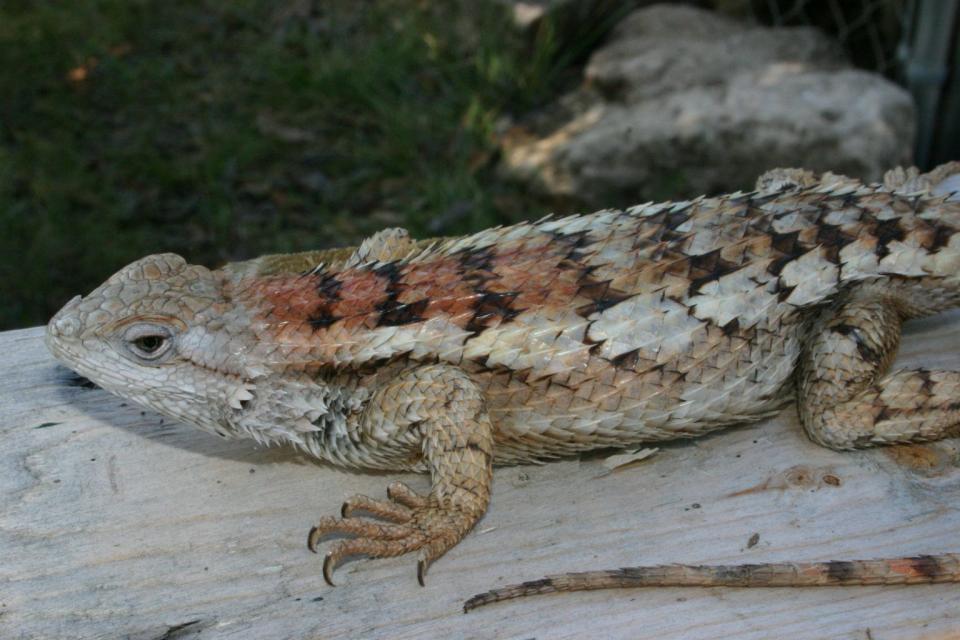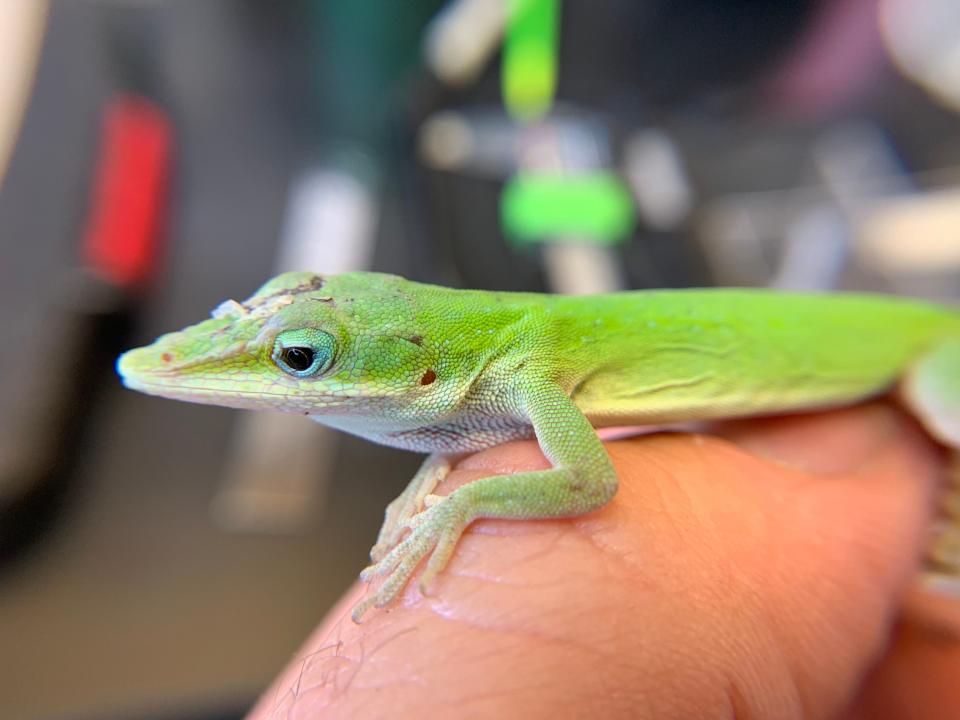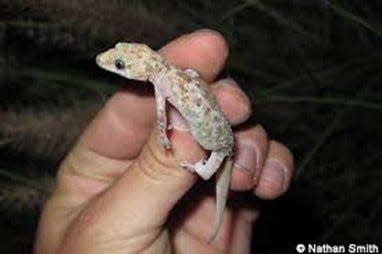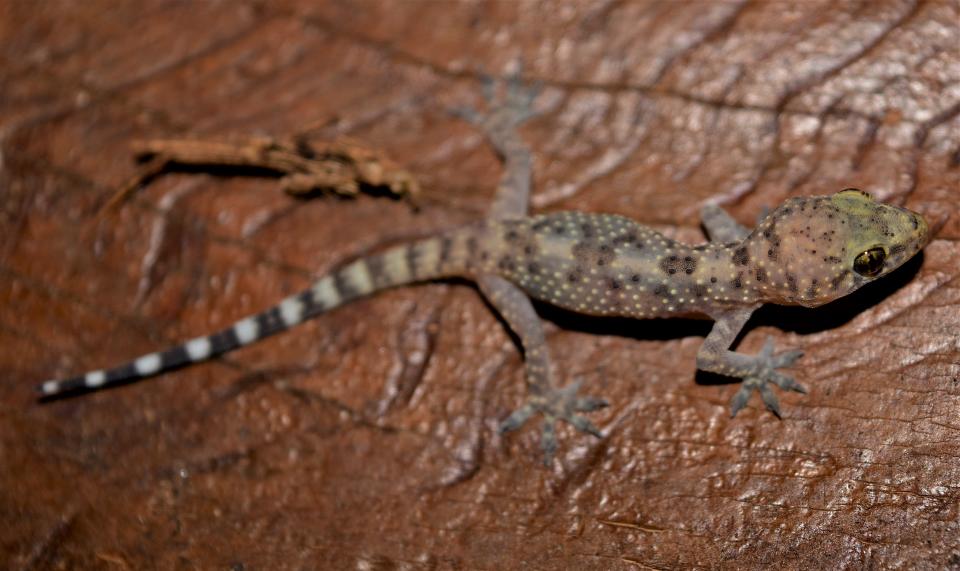Likable lizards in unlikely places
Whenever I think about habitats where I might find lizards, the first places where I would begin my search would be on the ground and underneath rocks, leaf litter, and/or other surface debris. However, our reptilian friends are often capable of giving us a surprise and some species are more commonly located in arboreal locations! Let’s discuss three likable area lizards specialized in above-ground living.
Texas spiny lizard and Eastern fence lizard
The Texas Spiny Lizard is a large (total length of 11 inches) lizard that is usually discovered in our area by searching the trunks and branches of large trees. However, it may also be found on smaller mesquite trees, fence posts and other structures; especially if brushy, understory vegetation is nearby. The Texas Spiny Lizard spends most of its life in trees, where it searches for insect meals of grasshoppers, cicadas, ants, flies, butterflies and moths and caterpillars. Although relatively large in size, it blends in with its tree habitations, so you must look closely to see the Texas Spiny Lizard in the trees. Also, if these lizards detect potential threats, they usually retreat to the opposite sides of tree trunks or branches away from predators or observers.

Female Texas Spiny Lizards are larger than males but both sexes possess prominent, large, keeled (having a ridge = rough to the touch) dorsal scales. Overall colors are a mixture of grayish brown with darker, wavy, transverse lines across the back and forelegs. Fingers, toes and claws are well-developed and aid in climbing and clinging to surfaces with minimal effort. The belly and throat of the smaller males have faint blue-colored patches and patterns mixed with white and gray colors. The smaller-sized Eastern Fence Lizard (total length of up to 7 inches) also occurs in our area and may occasionally be mistaken for the larger Texas Spiny Lizard. However, the Eastern Fence Lizard (or Prairie Lizard) is a more terrestrial-dwelling species and has smaller and more numerous rows of dorsal scales than the Texas Spiny Lizard. The Eastern Fence Lizard has 35 or more rows of dorsal scales from the back of its head to the base of its tail; whereas, the Texas Spiny Lizard has 33 or fewer dorsal scale rows.
![Native to the Southeast, eastern fence lizards are more common than many people realize because of their first-rate camouflage. [Photo courtesy Stephen Bennett]](https://s.yimg.com/ny/api/res/1.2/qgXBI7FDz7G.2pFGYh6thQ--/YXBwaWQ9aGlnaGxhbmRlcjt3PTk2MDtoPTYzMg--/https://media.zenfs.com/en/times-record-news/0ebeed7b526374e71454aa0af4f9d408)
Due to human activities and increases in brush and tree species throughout most of its range, the Texas Spiny Lizard has expanded its range in recent years. Also, this species produces multiple, large clutches of young throughout the spring and summer months. However, hatchlings are not reproductively mature until around two years of age! Therefore, although it is presently abundant in our area, the Texas Spiny Lizard is protected from commercial collection within Texas.
Green anole: 'The American chameleon'
Another native, arboreal artist occurring on the eastern edge of our area is the Green Anole. This smaller-sized, attractive lizard is (usually) a striking, green color on its dorsal side with a paler, cream-colored belly and throat. The Green Anole is also known as the ‘American Chameleon’ because no other native species of lizard is capable of the dramatic color changes performed by this anole! It can change its color from green to brown to a grayish color based upon its temperature, background, mood, or activities; however, the Green Anole is not really a true chameleon species. Its head is large, with a pointy snout and, during breeding season, males extend a large, throat fan so that colors ranging from pink to red may be displayed to females. Anoles have long tails which detach easily if the lizard is grasped by its tail. The tail will regrow but the replacement, appendage is often a different color than the original. Anoles have expanded toe pads that help them to cling to trees, branches, walls, and other structures where they search for various insect prey items.

Although not as common in the area as the previously-described spiny lizards, the Green Anole can be found in suitable environments associated with trees and in urban areas with appropriate woody vegetation, structures, and ample food supplies. The Green Anole is on the Texas ‘White List’ and may be collected for commercial use. Anoles also are a very popular with the pet trade throughout our region.

Our last species of tree climbing and wall-crawling lizard was imported from the North African and Mediterranean region and was first reported in Texas from Brownsville in the 1950s. This lizard may have first arrived on Texas shores via cargo ships, but has since proliferated and expanded its range to include the eastern and central half of Texas along with several other major, urban areas; perhaps being limited from parts of Texas and Oklahoma by colder winter temperatures. This lizard is, of course, the somewhat familiar (possibly via certain insurance commercials) Mediterranean Gecko!

Mediterranean Geckos are unusual in several ways. They possess large, lidless eyes and, unlike most species of lizards, are vocal; having a repertoire of small squeaks, clicks, and chirping sounds. Specialized toe pads with millions of microscopic, hair-like, setae help them "stick" to walls, branches, foliage, and other surfaces. Geckos may intentionally lose (and readily regrow) their tails to avoid predators and their tails will even wriggle for some time as an additional distraction (or attraction) to the predator! Their bodies are covered in granular scales with larger tubercles (bumps) and are usually tan to pinkish colored with brown spots. The overall color may become darker during daylight hours; perhaps helping the gecko blend in with its surroundings.
The Mediterranean Gecko is largely associated with humans and is most common in towns and urban areas in our region. Geckos are often seen around home, garage, shop and other lights during nighttime hours. Food items include small moths and other appropriately-sized, night-flying insects. The geckos may actively forage along walls or wait to ambush prey items near light sources. Geckos are most active in our area during the spring, summer and early fall months of the year. Several clutches of young may be produced during this active season. Females generally lay two eggs per clutch in crevices, behind wall boards, in planting bed debris, and other suitable locations.
Remember to "look up" into the trees and around other structures when you are next scouting through your area. If you are lucky, you may see one of these arboreal reptiles. And remember that these fascinating lizards are only a small fraction of the entire lizard fauna found in our area. Many others await your discovery!

Jim Goetze is a retired professor of biology and former chairperson of the Natural Sciences Department of Laredo College with an avid interest in all aspects of the natural world. He can be contacted at gonorthtxnature@gmail.com
This article originally appeared on Wichita Falls Times Record News: Likable lizards in unlikely places

